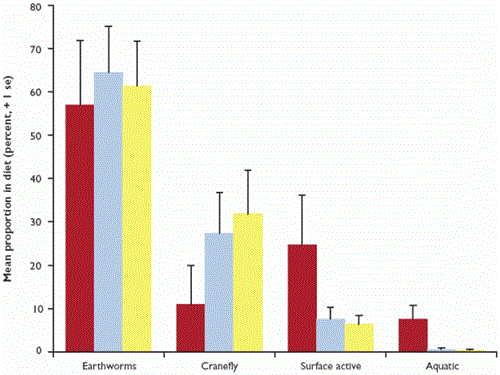Key findings
-
Snipe breeding on moorland was associated with marsh,acid flush and unimproved acid grassland.
-
Feeding locations were close to ditches or pools and characterised by damp soil.
-
Snipe diet during April-June consisted mainly of earthworms and cranefly larvae.
 Breeding snipe have declined in lowland Britain since the late 1940s as a result of agricultural intensification, such that they are now patchily distributed. Snipe are more widespread and numerous in northern Britain and Ireland and are regular breeders on moorland and rough pastures in upland areas. However, despite the increasing importance of these habitats, snipe ecology on moorland is poorly understood. Using data collected during the Upland Predation Experiment, we examined use of different habitats, the characteristics of feeding areas and snipe diet.
Breeding snipe have declined in lowland Britain since the late 1940s as a result of agricultural intensification, such that they are now patchily distributed. Snipe are more widespread and numerous in northern Britain and Ireland and are regular breeders on moorland and rough pastures in upland areas. However, despite the increasing importance of these habitats, snipe ecology on moorland is poorly understood. Using data collected during the Upland Predation Experiment, we examined use of different habitats, the characteristics of feeding areas and snipe diet.
Average snipe density across our four study areas was 2.28 birds per 100 hectares (approximately 1.14 pairs per 100 hectares). There was a large difference in density between habitats, with densities ranging from 0.97 bird per 100 hectares on improved grass to 5.44 birds per 100 hectares on marsh. Snipe densities on marsh were 3.4 times higher than on heath and heath-grass mix habitats (see Figure 1). Densities on acid grass were 2.7 times higher than on improved grassland.
Figure 1: Mean breeding snipe densities on different habitats across four moors in Northumberland

Comparison of 186 locations where snipe were disturbed during the day with 119 random points revealed no difference in vegetation height or density, but the sward was more tussocky at snipe flush sites. Taking into account differences between habitats, snipe locations were closer to wet ditches or pools than random points (averages 12 metres and 40 metres respectively) and the soil was wetter (average difference of one point on a five-point scale). Further comparison of habitat measures at snipe locations with evidence of recent feeding and locations where birds were presumed to be resting (no probe holes), showed that birds fed close to ditches or pools and used areas with wetter soil.
Microscopic examination of faeces revealed that earthworms, cranefly larvae and midge larvae were numerically the most important food items of adult snipe, but they also ate a wide range of surface-active and other aquatic invertebrates. Earthworms and cranefly larvae accounted for 85% of estimated dry weight ingested. Comparison with a study of snipe diet on lowland wet grassland indicates that cranefly larvae are taken more frequently and more aquatic groups (dragonfly nymphs, midge larvae, aquatic beetles, freshwater snails and mussels) are eaten on moorland. Diet changed between late April, mid-May and early June, with more surface-active and aquatic prey taken in late April and more cranefly larvae taken in mid-May and early June (see Figure 2). Earthworms were the most important food throughout.
The availability of feeding areas on moorland may limit breeding density, with only low densities likely on extensive areas of dry heath, but high densities likely in areas with a mosaic of habitats including patches of marshy grassland and acid flush (damp areas dominated by rushes and Sphagnum moss). Rough grassland is likely to provide the most earthworms, but the soft soil near ditches and flushes makes earthworms and cranefly larvae more accessible. Ditches and flushes also support a much higher abundance of insects than heather-dominated moorland and are frequently visited by other birds such as meadow pipits and red grouse when rearing broods.
Figure 2: Comparison of mean proportions of estimated dry weight of prey ingested between late April, mid-May and early June
